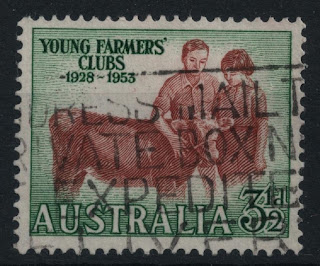On the 12th March 2013 Australia Post released a set of
stamps showing different Mountains/Ranges in Antarctica. There are four in
total Mount Parsons, Mawson Escarpment, South Masson Range and David Range.
The denominations of these stamps are 2 x 60c, 1 x $1.20
and 1 x $1.80 and are perforated 13.76 x 14.6.
These stamps were issued to continue the Australian
Antarctic Territory (AAT) Landscape series which began with the Iceberg issue
in June 2011.
Antarctica is the highest continent on earth with Mount
McClintock (11,450ft / 3490 meters),
in the Eastern Sector of the AAT being the highest mountain. Elevations in the
Western sector of the AAT exceed 13,123ft / 4000
meters, although these are ice domes and are generally not considered as
mountains.
The first 60c stamp shows Mount Parsons is a 3,675ft /
1,120m mountain peak in Antarctica and is located within the David Range, it
also ranks as the 2046th highest mountain in Antarctica.
Mount Parsons was mapped by Norwegians in 1936-37 by
aerial photos taken by the Lars Christensen Expedition. In January 1956, the
Australian National Antarctic Research Expeditions (ANARE) led by John
Bechervaise visited the peak.
It was names by Antarctic Names Committee of Australia
(ANCA) for Neville Parsons, who was a cosmic ray physicist at Mawson Station,
in 1955.
The next 60c stamp is Mawson Escarpment is a flat-topped
west facing escarpment which extends in a North-South direction for 70 miles / 112km which runs along the east side of the Lambert Glacier.
This escarpment was discovered by Flying Officer J.
Seaton of the RAAF and he was part of the Australian National Antarctic
Research Expeditions (ANARE) while on a investigation flight in November 1956.
This escarpment was named by the Antarctic Names
Committee of Australia (ANCA) for Sir Douglas Mawson.
The $1.20 stamp is the South Masson Range in to three
parts Northern, Central and Southern. This stamps is of the southern part and rises
to 3510ft / 1,070m and extends to 2 mile in a NE-SW arc.
In 1929-31 Masson Range was discovered and named by the British
Australian and New Zealand Antarctic Research Expedition (BANZARE), under Sir
Douglas Mawson.
The South Masson Range was mapped by Norwegians in
1936-37 by aerial photos taken by the Lars Christensen Expedition.
The approved name South Masson Range was suggested by the
Antarctic Names Committee of Australia (ANCA) in 1960.
The $1.80 stamp is of the David Range which is located 5
miles west of Masson Range which it runs parallel, in the Framnes Mountains.
The David Range extends 16 miles / 25km in a
NNE-SSW direction, with peaks rising to 4921ft
/ 1,500 meters.
The Range was discovered in February 1931 by the British
Australian and New Zealand Antarctic Research Expedition (BANZARE) under Sir
Douglas Mawson, who named it for Sir Tannatt William Edgeworth David.





